NETGEAR WNDR4000, N750 User Manual
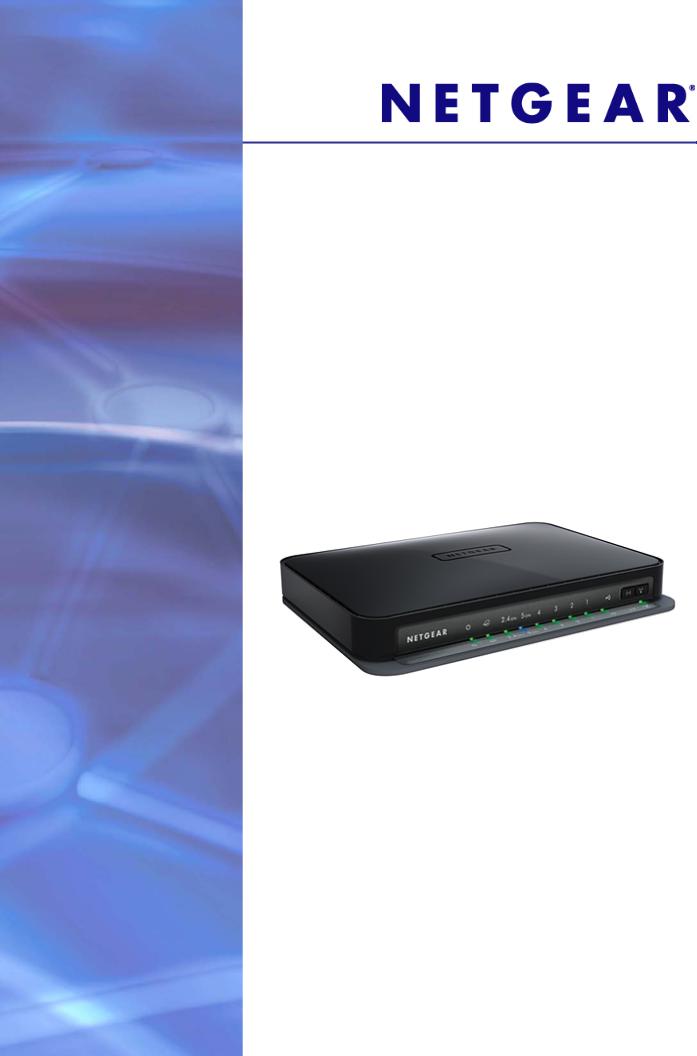
N750 Wireless Dual Band
Gigabit Router WNDR4000
User Manual
350 East Plumeria Drive
San Jose, CA 95134
USA
March 2011 202-10781-03 v1.0

N750 Wireless Dual Band Gigabit Router WNDR4000 User Manual
©2010 NETGEAR, Inc. All rights reserved.
No part of this publication may be reproduced, transmitted, transcribed, stored in a retrieval system, or translated into any language in any form or by any means without the written permission of NETGEAR, Inc.
Technical Support
Thank you for choosing NETGEAR. To register your product, get the latest product updates, or get support online, visit us at http://support.netgear.com.
Phone (US & Canada only): 1-888-NETGEAR
Phone (Other Countries): See Support information card.
Trademarks
NETGEAR, the NETGEAR logo, ReadyNAS, ProSafe, Smart Wizard, Auto Uplink, X-RAID2, and NeoTV are trademarks or registered trademarks of NETGEAR, Inc. Microsoft, Windows, Windows NT, and Vista are registered trademarks of Microsoft Corporation. Other brand and product names are registered trademarks or trademarks of their respective holders.
Statement of Conditions
To improve internal design, operational function, and/or reliability, NETGEAR reserves the right to make changes to the products described in this document without notice. NETGEAR does not assume any liability that may occur due to the use, or application of, the product(s) or circuit layout(s) described herein.
2 |

Contents
Chapter 1 Hardware Setup
Unpack Your Wireless Router . . . . . . . . . . . . . . . . . . . . . . . . . . . . . . . . . . . 8
Hardware Features. . . . . . . . . . . . . . . . . . . . . . . . . . . . . . . . . . . . . . . . . . . . 8
Front Panel . . . . . . . . . . . . . . . . . . . . . . . . . . . . . . . . . . . . . . . . . . . . . . . . 8
Back Panel . . . . . . . . . . . . . . . . . . . . . . . . . . . . . . . . . . . . . . . . . . . . . . . 10
Label. . . . . . . . . . . . . . . . . . . . . . . . . . . . . . . . . . . . . . . . . . . . . . . . . . . . 10
Router Stand . . . . . . . . . . . . . . . . . . . . . . . . . . . . . . . . . . . . . . . . . . . . . 11
Position Your Router . . . . . . . . . . . . . . . . . . . . . . . . . . . . . . . . . . . . . . . . . 11
Cable Your Router . . . . . . . . . . . . . . . . . . . . . . . . . . . . . . . . . . . . . . . . . . . 12
Verify the Cabling . . . . . . . . . . . . . . . . . . . . . . . . . . . . . . . . . . . . . . . . . . . . 13
Chapter 2 Set Up Your Internet Connection
Wireless Router Setup Preparation . . . . . . . . . . . . . . . . . . . . . . . . . . . . . . 16 Use Standard TCP/IP Properties for DHCP . . . . . . . . . . . . . . . . . . . . . . 16 Replace an Existing Router . . . . . . . . . . . . . . . . . . . . . . . . . . . . . . . . . . 16 Gather ISP Information. . . . . . . . . . . . . . . . . . . . . . . . . . . . . . . . . . . . . . 16 Log In to the Router . . . . . . . . . . . . . . . . . . . . . . . . . . . . . . . . . . . . . . . . . . 17 Upgrade Firmware . . . . . . . . . . . . . . . . . . . . . . . . . . . . . . . . . . . . . . . . . . . 18 Router Interface . . . . . . . . . . . . . . . . . . . . . . . . . . . . . . . . . . . . . . . . . . . . . 18 Setup Wizard . . . . . . . . . . . . . . . . . . . . . . . . . . . . . . . . . . . . . . . . . . . . . . . 19 Manual Setup (Basic Settings) . . . . . . . . . . . . . . . . . . . . . . . . . . . . . . . . . . 20 Unsuccessful Internet Connection . . . . . . . . . . . . . . . . . . . . . . . . . . . . . . . 23 Change Password . . . . . . . . . . . . . . . . . . . . . . . . . . . . . . . . . . . . . . . . . . . 23 Log Out Manually . . . . . . . . . . . . . . . . . . . . . . . . . . . . . . . . . . . . . . . . . . . . 24 Types of Logins . . . . . . . . . . . . . . . . . . . . . . . . . . . . . . . . . . . . . . . . . . . . . 24
Chapter 3 Wireless Settings
Wireless Security Compatibility . . . . . . . . . . . . . . . . . . . . . . . . . . . . . . . . . 26 Security Basics . . . . . . . . . . . . . . . . . . . . . . . . . . . . . . . . . . . . . . . . . . . . . . 26 Wireless Security Options . . . . . . . . . . . . . . . . . . . . . . . . . . . . . . . . . . . 26 Turn Off Wireless Connectivity . . . . . . . . . . . . . . . . . . . . . . . . . . . . . . . . 26 Disable SSID Broadcast . . . . . . . . . . . . . . . . . . . . . . . . . . . . . . . . . . . . . 27 Restrict Access by MAC Address. . . . . . . . . . . . . . . . . . . . . . . . . . . . . . 27 Add Clients (Computers or Devices) to Your Network . . . . . . . . . . . . . . . .27 Manual Method. . . . . . . . . . . . . . . . . . . . . . . . . . . . . . . . . . . . . . . . . . . . 27 Wi-Fi Protected Setup (WPS) Method . . . . . . . . . . . . . . . . . . . . . . . . . . 28 Wireless Settings Screen . . . . . . . . . . . . . . . . . . . . . . . . . . . . . . . . . . . . . . 29 Consider Every Device on Your Network . . . . . . . . . . . . . . . . . . . . . . . . 29 View or Change Wireless Settings . . . . . . . . . . . . . . . . . . . . . . . . . . . . . 30
Contents | 3

N750 Wireless Dual Band Gigabit Router WNDR4000 User Manual
Wireless Settings Screen Fields. . . . . . . . . . . . . . . . . . . . . . . . . . . . . . . 31
Set Up WPA Security Option and Passphrase. . . . . . . . . . . . . . . . . . . . 32
Wireless Guest Networks . . . . . . . . . . . . . . . . . . . . . . . . . . . . . . . . . . . . . . 32
Chapter 4 Content Filtering Settings
Logs . . . . . . . . . . . . . . . . . . . . . . . . . . . . . . . . . . . . . . . . . . . . . . . . . . . . . . 35
Examples of Log Messages . . . . . . . . . . . . . . . . . . . . . . . . . . . . . . . . . . 36
Keyword Blocking of HTTP Traffic . . . . . . . . . . . . . . . . . . . . . . . . . . . . . . . 37
Delete Keyword or Domain. . . . . . . . . . . . . . . . . . . . . . . . . . . . . . . . . . . 37
Specify a Trusted Computer. . . . . . . . . . . . . . . . . . . . . . . . . . . . . . . . . . 38
Block Services . . . . . . . . . . . . . . . . . . . . . . . . . . . . . . . . . . . . . . . . . . . . . . 38
Set the Time Zone . . . . . . . . . . . . . . . . . . . . . . . . . . . . . . . . . . . . . . . . . . . 40
Schedule Services . . . . . . . . . . . . . . . . . . . . . . . . . . . . . . . . . . . . . . . . . . . 41
Turn On Security Event Email Notification . . . . . . . . . . . . . . . . . . . . . . . . . 42
Port Forwarding . . . . . . . . . . . . . . . . . . . . . . . . . . . . . . . . . . . . . . . . . . . . . 43
Add a Custom Service . . . . . . . . . . . . . . . . . . . . . . . . . . . . . . . . . . . . . . 44
Application Example: Making a Local Web Server Public . . . . . . . . . . . 45
Port Triggering . . . . . . . . . . . . . . . . . . . . . . . . . . . . . . . . . . . . . . . . . . . . . . 46
Chapter 5 Network Maintenance
Upgrade the Firmware . . . . . . . . . . . . . . . . . . . . . . . . . . . . . . . . . . . . . . . . 50 Automatic Firmware Check . . . . . . . . . . . . . . . . . . . . . . . . . . . . . . . . . . 50 Stop the Automatic Firmware Check . . . . . . . . . . . . . . . . . . . . . . . . . . . 51 Manually Check for Firmware Upgrades . . . . . . . . . . . . . . . . . . . . . . . . . . 51 Manage the Configuration File . . . . . . . . . . . . . . . . . . . . . . . . . . . . . . . . . . 52 Back Up . . . . . . . . . . . . . . . . . . . . . . . . . . . . . . . . . . . . . . . . . . . . . . . . . 52 Restore . . . . . . . . . . . . . . . . . . . . . . . . . . . . . . . . . . . . . . . . . . . . . . . . . . 53 Erase . . . . . . . . . . . . . . . . . . . . . . . . . . . . . . . . . . . . . . . . . . . . . . . . . . . 53 View Router Status. . . . . . . . . . . . . . . . . . . . . . . . . . . . . . . . . . . . . . . . . . . 53 Internet Port Settings . . . . . . . . . . . . . . . . . . . . . . . . . . . . . . . . . . . . . . . 53 LAN Port (Local Ports) . . . . . . . . . . . . . . . . . . . . . . . . . . . . . . . . . . . . . . 54 Wireless Port . . . . . . . . . . . . . . . . . . . . . . . . . . . . . . . . . . . . . . . . . . . . . 54 Show Statistics . . . . . . . . . . . . . . . . . . . . . . . . . . . . . . . . . . . . . . . . . . . . 54 Connection Status . . . . . . . . . . . . . . . . . . . . . . . . . . . . . . . . . . . . . . . . . 55 View Attached Devices. . . . . . . . . . . . . . . . . . . . . . . . . . . . . . . . . . . . . . . . 56
Chapter 6 USB Storage
USB Drive Requirements . . . . . . . . . . . . . . . . . . . . . . . . . . . . . . . . . . . . . . 58
File-Sharing Scenarios . . . . . . . . . . . . . . . . . . . . . . . . . . . . . . . . . . . . . . . . 58
Share Photos within Your Home Network . . . . . . . . . . . . . . . . . . . . . . . 58
Share Large Files with FTP over the Internet. . . . . . . . . . . . . . . . . . . . . 59
USB Storage Basic Settings. . . . . . . . . . . . . . . . . . . . . . . . . . . . . . . . . . . . 59
Basic Settings Screen Fields and Buttons . . . . . . . . . . . . . . . . . . . . . . . 60
Edit a Network Folder. . . . . . . . . . . . . . . . . . . . . . . . . . . . . . . . . . . . . . . . . 60
USB Storage Advanced Settings . . . . . . . . . . . . . . . . . . . . . . . . . . . . . . . . 61
Create a Network Folder . . . . . . . . . . . . . . . . . . . . . . . . . . . . . . . . . . . . 63
4 | Contents

N750 Wireless Dual Band Gigabit Router WNDR4000 User Manual
Unmount a USB Drive . . . . . . . . . . . . . . . . . . . . . . . . . . . . . . . . . . . . . . . .63 Approved USB Devices . . . . . . . . . . . . . . . . . . . . . . . . . . . . . . . . . . . . . . .64 Connect to the USB Drive from a Remote Computer. . . . . . . . . . . . . . . . .64 Locate the Internet Port IP Address . . . . . . . . . . . . . . . . . . . . . . . . . . . .65 Access the Modem Router’s USB Drive Remotely with FTP . . . . . . . . .65 Connect to the USB Drive with Microsoft Network Settings . . . . . . . . . . . .65 Enabling File and Printer Sharing . . . . . . . . . . . . . . . . . . . . . . . . . . . . . .65
Chapter 7 Advanced Settings
WAN Setup. . . . . . . . . . . . . . . . . . . . . . . . . . . . . . . . . . . . . . . . . . . . . . . . .68
Default DMZ Server . . . . . . . . . . . . . . . . . . . . . . . . . . . . . . . . . . . . . . . .69
Dynamic DNS . . . . . . . . . . . . . . . . . . . . . . . . . . . . . . . . . . . . . . . . . . . . . . .70
LAN Setup . . . . . . . . . . . . . . . . . . . . . . . . . . . . . . . . . . . . . . . . . . . . . . . . .71
LAN Setup Screen Settings . . . . . . . . . . . . . . . . . . . . . . . . . . . . . . . . . .72
IP Address Reservation . . . . . . . . . . . . . . . . . . . . . . . . . . . . . . . . . . . . .72
Quality of Service (QoS). . . . . . . . . . . . . . . . . . . . . . . . . . . . . . . . . . . . . . .73
QoS for Internet Access . . . . . . . . . . . . . . . . . . . . . . . . . . . . . . . . . . . . .73
Advanced Wireless Settings. . . . . . . . . . . . . . . . . . . . . . . . . . . . . . . . . . . .74
Wireless Advanced Settings (2.4 GHz and 5 GHz) . . . . . . . . . . . . . . . .75
WPS Settings . . . . . . . . . . . . . . . . . . . . . . . . . . . . . . . . . . . . . . . . . . . . .75
Wireless Card Access List . . . . . . . . . . . . . . . . . . . . . . . . . . . . . . . . . . .75
Remote Management Access . . . . . . . . . . . . . . . . . . . . . . . . . . . . . . . . . .76
Static Routes . . . . . . . . . . . . . . . . . . . . . . . . . . . . . . . . . . . . . . . . . . . . . . .78
Static Route Example . . . . . . . . . . . . . . . . . . . . . . . . . . . . . . . . . . . . . . .78
Add a Static Route . . . . . . . . . . . . . . . . . . . . . . . . . . . . . . . . . . . . . . . . .79
Universal Plug and Play . . . . . . . . . . . . . . . . . . . . . . . . . . . . . . . . . . . . . . .80
IPv6 . . . . . . . . . . . . . . . . . . . . . . . . . . . . . . . . . . . . . . . . . . . . . . . . . . . . . .81
Traffic Meter . . . . . . . . . . . . . . . . . . . . . . . . . . . . . . . . . . . . . . . . . . . . . . . .81
Advanced USB Settings . . . . . . . . . . . . . . . . . . . . . . . . . . . . . . . . . . . . . . .83
Wireless Bridging and Repeating Networks . . . . . . . . . . . . . . . . . . . . . . . .83
Set Up a Repeater with Wireless Client Association . . . . . . . . . . . . . . .85
Chapter 8 Troubleshooting
Quick Tips. . . . . . . . . . . . . . . . . . . . . . . . . . . . . . . . . . . . . . . . . . . . . . . . . .88 Sequence to Restart Your Network . . . . . . . . . . . . . . . . . . . . . . . . . . . .88 Power LED . . . . . . . . . . . . . . . . . . . . . . . . . . . . . . . . . . . . . . . . . . . . . . .88 Check Ethernet Cable Connections . . . . . . . . . . . . . . . . . . . . . . . . . . . .88 Wireless Settings . . . . . . . . . . . . . . . . . . . . . . . . . . . . . . . . . . . . . . . . . .88 Network Settings. . . . . . . . . . . . . . . . . . . . . . . . . . . . . . . . . . . . . . . . . . .89
Troubleshooting with the LEDs. . . . . . . . . . . . . . . . . . . . . . . . . . . . . . . . . .89 Power LED Is Off or Blinking . . . . . . . . . . . . . . . . . . . . . . . . . . . . . . . . .89 LEDs Never Turn Off . . . . . . . . . . . . . . . . . . . . . . . . . . . . . . . . . . . . . . .89 Internet or Ethernet Port LEDs Are Off . . . . . . . . . . . . . . . . . . . . . . . . . .90 Wireless LED Is Off . . . . . . . . . . . . . . . . . . . . . . . . . . . . . . . . . . . . . . . .90
Cannot Log In to the Wireless Router . . . . . . . . . . . . . . . . . . . . . . . . . . . .90 Cannot Access the Internet . . . . . . . . . . . . . . . . . . . . . . . . . . . . . . . . . . . .91 Changes Not Saved . . . . . . . . . . . . . . . . . . . . . . . . . . . . . . . . . . . . . . . . . .92
Contents | 5

N750 Wireless Dual Band Gigabit Router WNDR4000 User Manual
Incorrect Date or Time . . . . . . . . . . . . . . . . . . . . . . . . . . . . . . . . . . . . . . . . 92 Wireless Connectivity . . . . . . . . . . . . . . . . . . . . . . . . . . . . . . . . . . . . . . . . . 93 Wireless Signal Strength . . . . . . . . . . . . . . . . . . . . . . . . . . . . . . . . . . . . 93 Restoring the Factory Settings and Password . . . . . . . . . . . . . . . . . . . . . . 93
Appendix A Supplemental Information
Factory Settings . . . . . . . . . . . . . . . . . . . . . . . . . . . . . . . . . . . . . . . . . . . . . 94
Technical Specifications. . . . . . . . . . . . . . . . . . . . . . . . . . . . . . . . . . . . . . . 96
Appendix B Notification of Compliance
Index
6 | Contents

1. Hardware Setup |
1 |
|
|
||
|
|
|
The N750 Wireless Dual Band Gigabit Router WNDR4000 User Manual provides you with an easy and secure way to set up a wireless home network with fast access to the Internet over a high-speed digital subscriber line (DSL). It has is compatible with all major DSL Internet service providers, lets you block unsafe Internet content and applications, and protects the devices (PCs, gaming consoles, and so on) that you connect to your home network.
For more information about the topics covered in this manual, visit the Support website at http://support.netgear.com.
If you have not already set up your new wireless router using the installation guide that comes in the box, this chapter walks you through the hardware setup. Chapter 2, Set Up Your Internet Connection explains how to set up your Internet connection.
This chapter contains the following sections:
•Unpack Your Wireless Router
•Hardware Features
•Position Your Router
•Cable Your Router
•Verify the Cabling
Chapter 1. Hardware Setup | 7
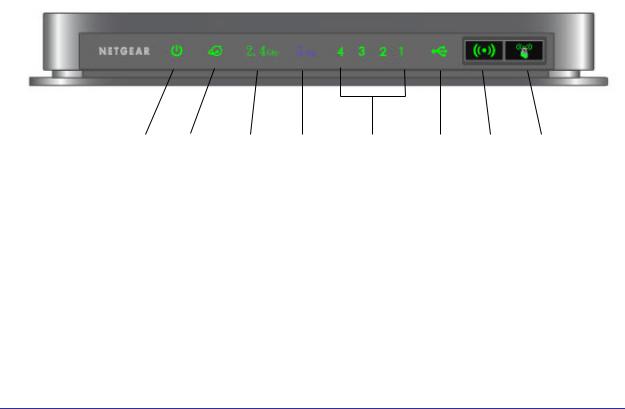
N750 Wireless Dual Band Gigabit Router WNDR4000 User Manual
Unpack Your Wireless Router
Your box should contain the following items:
•N750 Wireless Dual Band Gigabit Router WNDR4000
•Router stand
•AC power adapter (plug varies by region)
•Category 5 (Cat 5) Ethernet cable
•Resource CD
•Installation guide with cabling and wireless router setup instructions
If any parts are incorrect, missing, or damaged, contact your NETGEAR dealer. Keep the carton and original packing materials, in case you need to return the product for repair.
Hardware Features
Before you cable your wireless router, take a moment to become familiar with the label and the front and back panels. Pay particular attention to the LEDs on the front panel.
Front Panel
The wireless router front panel has the status LEDs and icons shown in the figure. Note that the Wireless and WPS icons are buttons.
Power Internet 2.4 GHz 5 GHz LAN Ports USB Wireless WPS (1–4)
Figure 1. Front panel LEDs and icons
8 | Chapter 1. Hardware Setup

N750 Wireless Dual Band Gigabit Router WNDR4000 User Manual
The following table describes the LEDs, icons, and buttons on the front panel from left to right.
Icon |
Description |
|
|
Power |
• Solid amber. The unit is starting up after being powered on. |
|
• Solid green. Power is supplied to the wireless router. |
|
• Off. Power is not supplied to the wireless router. |
|
• Blinking green. The firmware is corrupted. See www.netgear.com/support. |
|
• Blinking amber. The firmware is upgrading, or the Restore Factory Settings button |
|
was pressed. |
Internet |
• Solid green. An IP address has been received; ready to transmit data. |
|
• Solid amber. The Ethernet cable connection to the modem has been detected. |
|
• Off. No Ethernet cable is connected to the modem. |
|
|
2.4 GHz |
• Solid green. The 2.4 GHz wireless radio is operating. |
|
• Off. The 2.4 GHz wireless radio is off. |
|
|
5 GHz |
• Solid blue. The 5 GHz wireless radio is operating. |
|
• Off. The 5 GHz wireless radio is off. |
|
|
LAN |
• Solid green. The LAN port has detected a 1 Gbps link with an attached device. |
|
• Solid amber. The LAN port has detected a 10/100 Mbps link with an attached device. |
|
• Off. No link is detected on this port. |
|
|
USB |
• Solid green. The USB device had been accepted by the router and is ready to be used. |
|
• Blinking green. The USB device is in use. |
|
• Off. No USB device is connected, or the Safely Remove Hardware button has been |
|
clicked and it is now safe to remove the attached USB device. |
|
|
Wireless |
Pressing this button turns the wireless radios on and off. |
button |
• On. The 2.4 GHz and 5 GHz wireless radios are on. |
|
• Off. The 2.4 GHz and 5 GHz wireless radios are off, and the 24 GHz and 5 GHz LEDs |
|
are off. |
|
|
WPS button |
Pressing this button allows you to use Wi-Fi Protected Setup (WPS) to add a wireless |
|
device or computer to your network (see Wi-Fi Protected Setup (WPS) Method on |
|
page 28. The WPS LED blinks for 2 minutes during this process. |
|
|
Chapter 1. Hardware Setup | 9
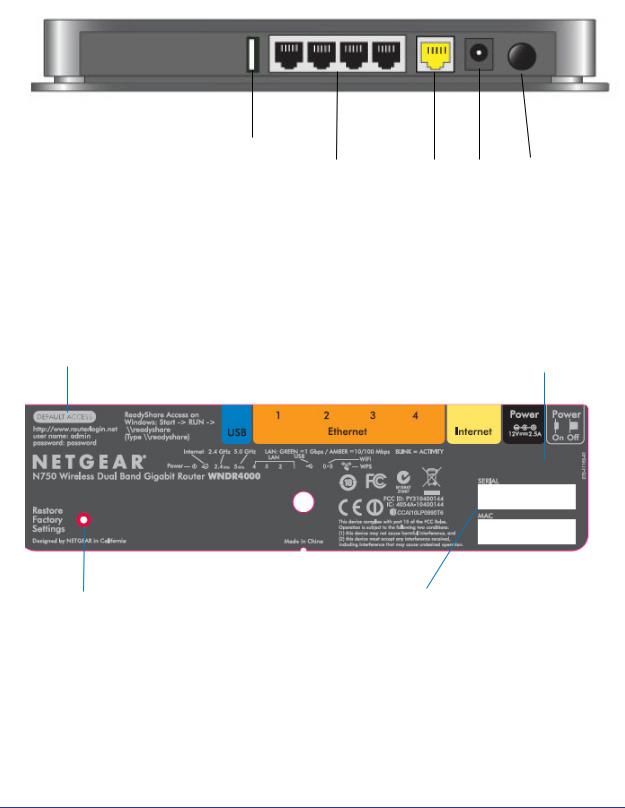
N750 Wireless Dual Band Gigabit Router WNDR4000 User Manual
Back Panel
The back panel has the On/Off button and port connections as shown in the figure.
USB
4 Ethernet |
ADSL Power On/Off |
LAN ports |
|
Figure 2. Back panel
Label
The label on the bottom of the wireless router shows the Restore Factory Settings button, WPS PIN, login information, MAC address, and serial number.
Login user name and |
|
default password |
WPS PIN |
|
Restore Factory Settings |
Serial number MAC |
|
address |
|
Figure 3. Label on wireless router bottom
See Factory Settings on page 94 for information about restoring factory settings.
10 | Chapter 1. Hardware Setup
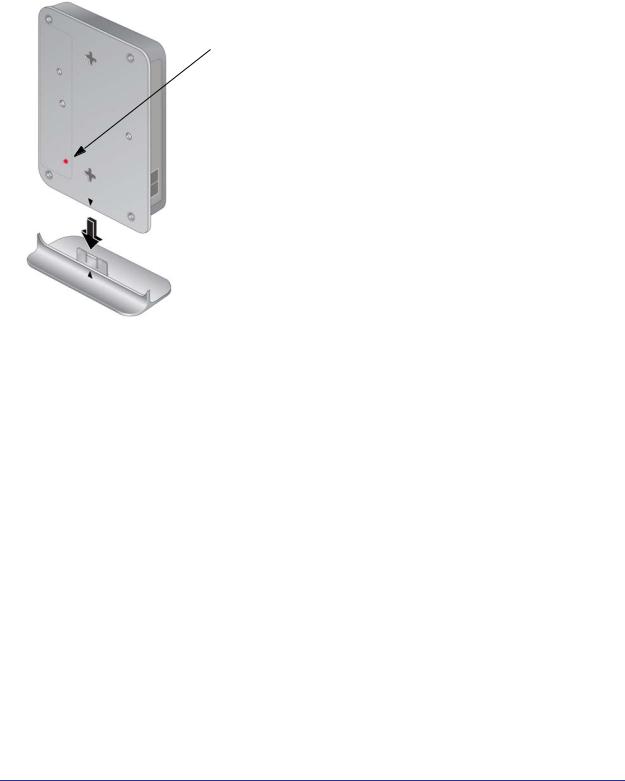
N750 Wireless Dual Band Gigabit Router WNDR4000 User Manual
Router Stand
For optimal wireless network performance, use the stand (included in the package) to position your wireless router upright.
Reset
Factory Settings button
1.Orient your wireless router vertically.
2.Insert the tabs of the stand into the slots on the bottom of your wireless router as shown.
3.Place your wireless router in a suitable area for installation (near an AC power outlet and accessible to the Ethernet cables for your wired computers).
Position Your Router
The wireless router lets you access your network from virtually anywhere within the operating range of your wireless network. However, the operating distance or range of your wireless connection can vary significantly depending on the physical placement of your wireless router. For example, the thickness and number of walls the wireless signal passes through can limit the range. For best results, place your wireless router:
•Near the center of the area where your computers and other devices operate, and preferably within line of sight to your wireless devices.
•So it is accessible to an AC power outlet and near Ethernet cables for wired computers.
•In an elevated location such as a high shelf, keeping the number of walls and ceilings between the wireless router and your other devices to a minimum.
•Away from electrical devices that are potential sources of interference, such as ceiling fans, home security systems, microwaves, PCs, or the base of a cordless phone or 2.4 GHz cordless phone.
Chapter 1. Hardware Setup | 11
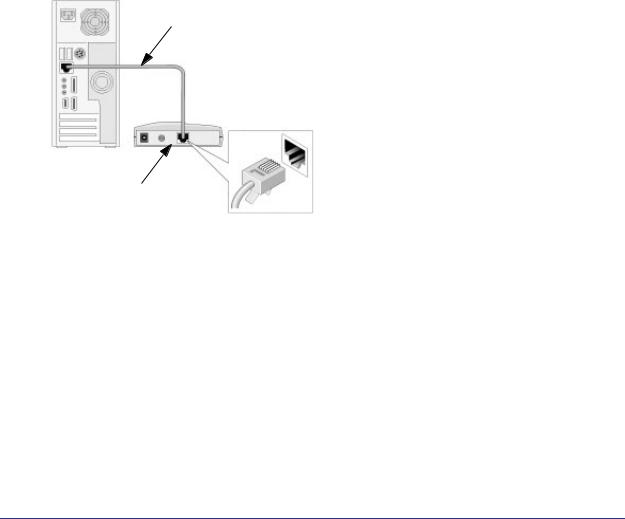
N750 Wireless Dual Band Gigabit Router WNDR4000 User Manual
•Away from any large metal surfaces, such as a solid metal door or aluminum studs. Large expanses of other materials such as glass, insulated walls, fish tanks, mirrors, brick, and concrete can also affect your wireless signal.
•With the antennas in a vertical position to provide the best side-to-side coverage or in a horizontal position to provide the best up-and-down coverage, as applicable.
When you use multiple access points, it is better if adjacent access points use different radio frequency channels to reduce interference. The recommended channel spacing between adjacent access points is 5 channels (for example, use Channels 1 and 6, or 6 and 11).
Cable Your Router
The installation guide that came in the box has a cabling diagram on the first page. This section walks you through cabling with detailed illustrations.
1.Connect the wireless router, the computer, and the modem.
2.Turn off and unplug the modem. If your modem has a backup battery, remove it as well.
3.Locate the Ethernet cable (1) that connects your computer to the modem.
1
2
Figure 4. Disconnect the modem from your computer
4. Disconnect the cable from the modem (2). You will connect it to the router later.
12 | Chapter 1. Hardware Setup
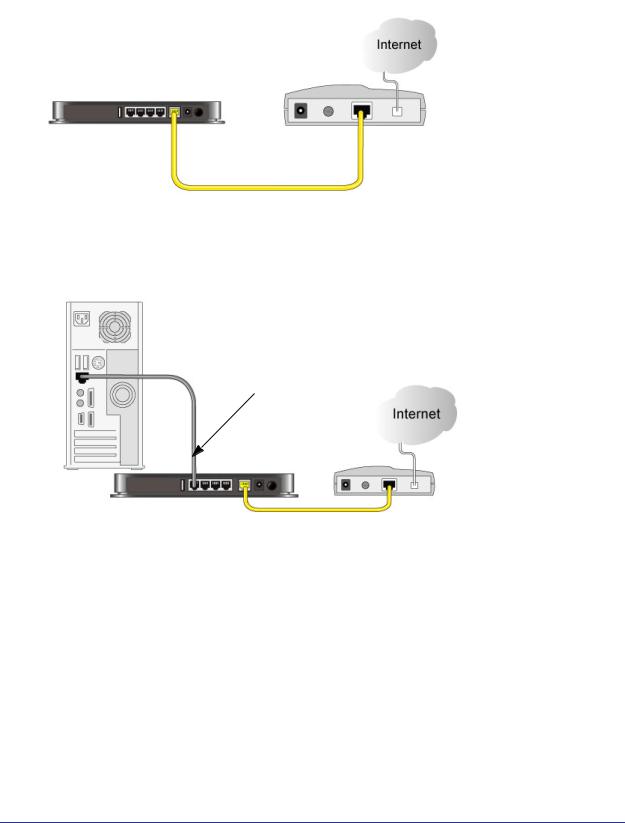
N750 Wireless Dual Band Gigabit Router WNDR4000 User Manual
5.Locate the Ethernet cable that came with the NETGEAR product. Securely insert that Ethernet cable into your modem and into the Internet port of the wireless router (3).
Figure 5. Connect the modem to the router
6.Locate the cable you removed from the modem in step 2. Securely insert that cable (4) into a LAN port on the router such as LAN port 1.
4
Figure 6. Connect the router to your computer
7.Your network cables are connected, and you are ready to start your network. It is important that you start your network in the correct sequence (first power on the modem, and after it finishes starting up, power on the router).
Verify the Cabling
Verify that your wireless router is cabled correctly by checking the wireless router LEDs. Turn on the wireless router by pressing the On/Off button on the back.
• The Power LED is green when the wireless router is turned on.
The Power LED is green when the wireless router is turned on.
• The LAN ports are green for each PC cabled to the wireless router by an Ethernet cable.
The LAN ports are green for each PC cabled to the wireless router by an Ethernet cable.
Chapter 1. Hardware Setup | 13

N750 Wireless Dual Band Gigabit Router WNDR4000 User Manual
•  The 2.4 GHz N/G-Band LED is on, and the 5.0 GHz N-Band LED is on.
The 2.4 GHz N/G-Band LED is on, and the 5.0 GHz N-Band LED is on.
• The Internet LED is on. If it is not, make sure that the Ethernet cable is securely attached to the wireless router Internet port and the modem, and that the modem is powered on.
Verify that the LAN  LEDs (1 through 4) are lit for any computers cabled to the wireless router by an Ethernet cable.
LEDs (1 through 4) are lit for any computers cabled to the wireless router by an Ethernet cable.
14 | Chapter 1. Hardware Setup

2. Set Up Your Internet Connection |
2 |
|
|
||
|
|
|
This chapter explains how to set up your Internet connection using one of two methods: the Setup Wizard, or manual setup. If you have already set up your wireless router using one of these methods, the initial setup is complete. Refer to this chapter if you want to become familiar with the wireless router menus and screens, view or adjust the initial settings, or change the wireless router password and login time-out.
This chapter contains the following sections:
•Wireless Router Setup Preparation
•Log In to the Router
•Upgrade Firmware
•Router Interface
•Setup Wizard
•Manual Setup (Basic Settings)
•Unsuccessful Internet Connection
•Change Password
•Log Out Manually
•Types of Logins
Chapter 2. Set Up Your Internet Connection | 15

N750 Wireless Dual Band Gigabit Router WNDR4000 User Manual
Wireless Router Setup Preparation
You can set up your wireless router with the Setup Wizard as described in Setup Wizard on page 19, or manually as described in Manual Setup (Basic Settings) on page 20. However, before you start the setup process, you need to have your ISP information and to make sure the laptops, PCs, and other devices in the network have the settings described here.
Note: For a Macintosh or Linux system, you have to use manual setup.
Use Standard TCP/IP Properties for DHCP
If you set up your computer to use a static IP address, you have to change the settings back so that it uses Dynamic Host Configuration Protocol (DHCP).
Replace an Existing Router
To replace an existing router, disconnect it and set it aside before starting the wireless router setup.
Gather ISP Information
You need the following information to set up your wireless router and to check that your Internet configuration is correct. Your Internet service provider (ISP) should have provided you with all the information needed to connect to the Internet. If you cannot locate this information, ask your ISP to provide it. When your wireless router Internet connection is set up, you no longer need to launch the ISP’s login program on your computer to access the Internet. When you start an Internet application, your wireless router automatically logs you in.
•Active Internet service provided by a DSL account
•The ISP configuration information for your DSL account
-ISP login name and password
-ISP Domain Name Server (DNS) addresses
-Fixed or static IP address
-Host and domain names
Depending on how your ISP set up your Internet account, you could need to know one or more of these settings for a manual setup:
•Virtual path identifier (VPI) and virtual channel identifier (VCI) parameters
•Multiplexing method
•Host and domain names
16 | Chapter 2. Set Up Your Internet Connection
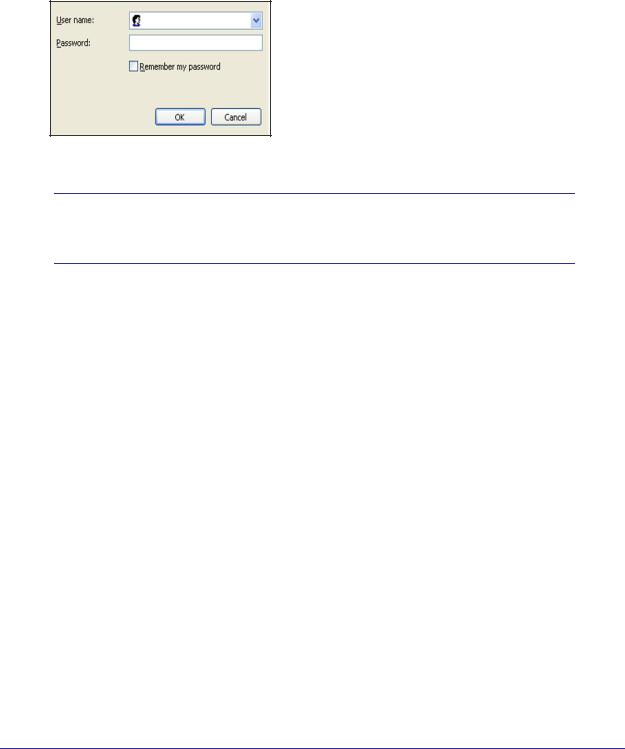
N750 Wireless Dual Band Gigabit Router WNDR4000 User Manual
Log In to the Router
Log in to the wireless router to view or change settings or to set up the wireless router.
1.Type wwww.routerlogin.net in the address field of your browser and press Enter to display the login window.
2. Enter admin for the user name and password for the password, both in lowercase letters.
Note: The wireless router user name and password are probably different from the user name and password for logging in to your Internet connection. See Types of Logins on page 24 for more information.
The wireless router screen displays as described in Router Interface on page 18.
If you do not see the login prompt:
1.Check the LEDs on the wireless router front panel to make sure that the wireless router is plugged into an electrical outlet, its power is on, and the Ethernet cable between your computer and the wireless router is connected to a LAN port.
2.If you connected the Ethernet cable and quickly launched your browser and typed in the wireless router URL, your computer might need a minute or two to recognize the LAN connection. Relaunch your browser and try again.
3.If you are having trouble accessing the wireless router wirelessly, NETGEAR recommends that during setup you use an Ethernet cable to connect your computer so that you can log in to the wireless router.
4.If you cannot connect to the wireless router, check the Internet Protocol (TCP/IP) properties in the Network Connections section of your PC Control Panel. They should be set to obtain both IP and DNS server addresses automatically. See your computer documentation.
Chapter 2. Set Up Your Internet Connection | 17
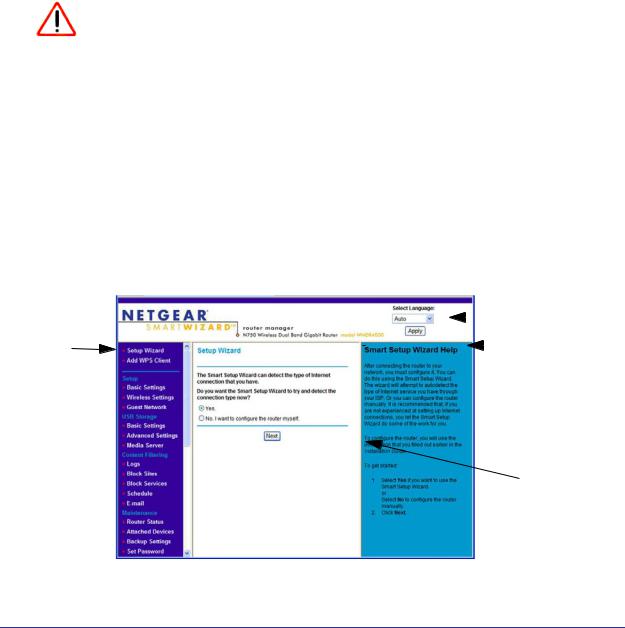
N750 Wireless Dual Band Gigabit Router WNDR4000 User Manual
Upgrade Firmware
When you log in, if you are connected to the Internet, the Firmware Upgrade Assistant screen displays so you can upgrade to the latest firmware. See Upgrade the Firmware on page 50, for more information about upgrading firmware.
Click Yes to check for new firmware (recommended). The wireless router checks the NETGEAR database for new firmware.
•If no new firmware is available, click No to exit. You can check for new firmware later.
•If new firmware is available, click Yes to upgrade the wireless router with the latest firmware. After the upgrade, the wireless router restarts.
CAUTION:
Do not try to go online, turn off the wireless router, shut down the computer, or do anything else to the wireless router until the wireless router finishes restarting and the Power LED has stopped blinking for several seconds.
You cannot upgrade firmware until you have established your Internet connection as described in Setup Wizard on page 19.
Router Interface
The wireless router interface lets you view or change the wireless router settings. The left column has menus, and the right column provides online help. The middle column is the screen for the current menu option.
|
|
|
|
|
|
Language |
|
|
|
|
|
|
|
Menus |
|
|
|
|
|
Help for the |
|
|
|
|
|
||
(scroll |
|
|
|
|
|
current screen |
down to |
|
|
|
|
|
|
view |
|
|
|
|
|
|
more) |
|
|
|
|
|
|
|
|
|
|
|
|
Screen selected |
|
|
|
|
|
|
|
|
|
|
|
|
|
from the menu |
|
|
|
|
|
|
|
Figure 1. Router interface |
|
|
||||
18 | Chapter 2. Set Up Your Internet Connection
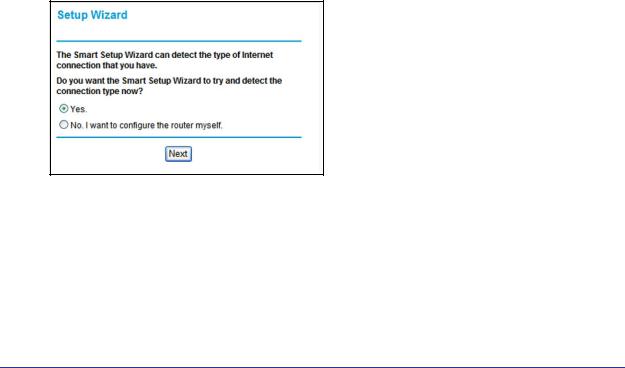
N750 Wireless Dual Band Gigabit Router WNDR4000 User Manual
•Setup Wizard. Specify the language and location, and automatically detect the Internet connection. See Setup Wizard on page 19.
•Add WPS Client. Add WPS-compatible wireless devices and other equipment to your wireless network. See Wi-Fi Protected Setup (WPS) Method on page 28.
•Setup menu. Set, upgrade, and check the ISP and wireless network settings of your wireless router. See Manual Setup (Basic Settings) on page 20 and Chapter 3, Wireless Settings for information about settings.
•Content Filtering menu. View and configure the wireless router firewall settings to prevent objectionable content from reaching your PCs. See Chapter 4, Content Filtering Settings.
•Maintenance menu. Administer and maintain your wireless router and network. See
Chapter 5, Network Maintenance.
•Advanced menu. Set the wireless router up for unique situations such as when remote access by IP or by domain name from the Internet is needed. See Chapter 7, Advanced Settings. Using this menu requires a solid understanding of networking concepts.
•Web Support. Go to the NETGEAR support site to get information, help, and product documentation. These links work once you have an Internet connection.
Setup Wizard
If you do not use the NETGEAR Genie, you have to log in to the wireless router to set the country, language, and Internet connection. If you performed the NETGEAR Genie setup, the country, language, Internet, and wireless network settings are already configured.
1.From the top of the wireless router menu, select Setup Wizard to display the following screen:
2.Select either Yes or No, I want to configure the router myself. If you selected No, proceed to Manual Setup (Basic Settings) on page 20.
3.If you selected Yes, click Next.
With automatic Internet detection, the Setup Wizard searches your Internet connection for servers and protocols to determine your ISP configuration.
Chapter 2. Set Up Your Internet Connection | 19

N750 Wireless Dual Band Gigabit Router WNDR4000 User Manual
Note: The Setup Wizard cannot detect a Point-to-Point Tunneling Protocol (PPTP) connection. If your ISP uses PPTP, you have to set your Internet connection through the screen described in Manual Setup (Basic Settings) on page 20.
Manual Setup (Basic Settings)
The Basic Settings screen displays when you select No. I want to configure the router myself in the Setup Wizard and is also available from the wireless router menu. It is where you view or change ISP information. The fields that display vary depending on whether or not your Internet connection requires a login.
Note: Check that the country is set as described Setup Wizard on page 19 before proceeding with the manual setup.
1.Select Set Up > Basic Settings, and select Yes or No depending on whether or not your ISP requires a login. Figure 2, Basic Settings screen without (left) and with (right) login shows both forms of the Basic Settings screen.
•Yes. Select the encapsulation method and enter the login name. If you want to change the login time-out, enter a new value in minutes.
•No. Enter the account and domain names, as needed.
2.Enter the settings for the IP address and DNS server. The default DSL settings usually work fine. If you have problems with your connection, check the DSL settings, and see
Unsuccessful Internet Connection on page 23 for more information.
3.If no login is required, you can specify the MAC Address setting.
4.Click Apply to save your settings.
20 | Chapter 2. Set Up Your Internet Connection
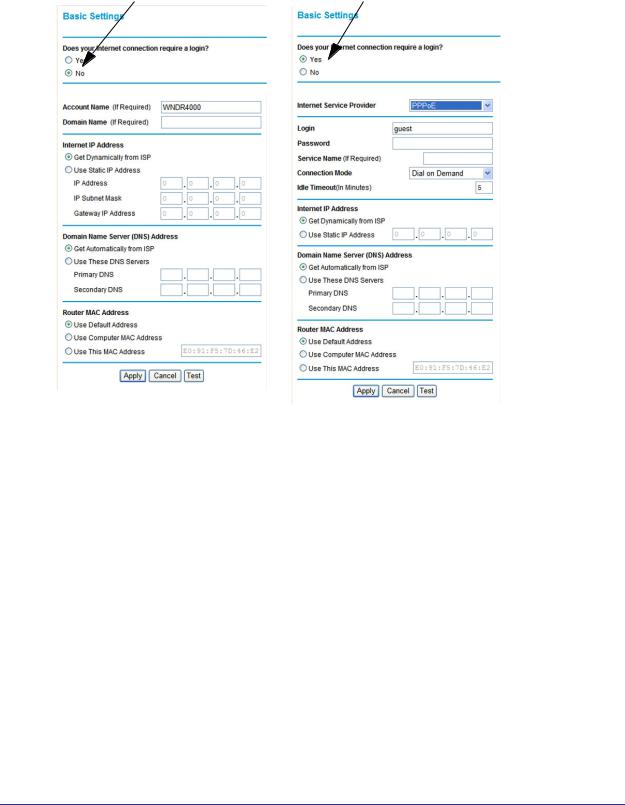
N750 Wireless Dual Band Gigabit Router WNDR4000 User Manual
5.Click Test to test your Internet connection. If the NETGEAR website does not appear within 1 minute, and see Chapter 8, Troubleshooting.
ISP does not require login |
ISP does require login |
|
|
|
|
|
|
|
Figure 2. Basic Settings screen without (left) and with (right) login
Some of the fields in this screen change when you select the Yes or No radio button for an ISP login.
•Yes. Select the encapsulation method and enter the login name. If you want to change the login time-out, enter a new value in minutes.
•No. Enter the account and domain names, as needed.
No ISP Login
•Account Name. Enter the account name provided by your ISP. This might also be called the host name.
•Domain Name. Enter the domain name provided by your ISP.
ISP Login
•Internet Service Provider.
PPTP (Point-to-Point Tunneling Protocol). This is used primarily in Austrian DSL services.
Chapter 2. Set Up Your Internet Connection | 21

N750 Wireless Dual Band Gigabit Router WNDR4000 User Manual
Telstra Bigpond. This setting is only for older cable modem service accounts that still require a Bigpond login utility. Telstra has discontinued this type of account. Those with Telstra DSL accounts and newer cable modem accounts should select No for Does your Internet connection require a login?.
Other. This is the default setting. It is for PPPoE (Point to Point Protocol over Ethernet), the protocol used by most DSL services worldwide.
•Login. The login name provided by your ISP. This is often an e-mail address.
•Password. The password provided by your ISP.
•Service Name. If your ISP provided a service name, enter it here.
•Connection Mode. Specify when the router will connect to and disconnect from the Internet.
Always On. The router logs in to the Internet immediately after booting and never disconnects.
Dial on Demand. The router logs in only when outgoing traffic is present and logs out after the idle time-out.
Manually Connect. The router logs in or logs out only when you click Connect or Disconnect in the Router Status screen.
•Idle Timeout. If you want to change the Internet login time-out, enter a new value in minutes. This determines how long the wireless router keeps the Internet connection active after there is no Internet activity from the LAN. Entering an Idle Timeout value of 0 (zero) means never log out.
•Internet IP Address
Get Dynamically from ISP. Your ISP uses DHCP to assign your IP address. Your ISP automatically assigns these addresses.
Use Static IP Address. Enter the IP address that your ISP assigned. Also enter the IP subnet mask and the gateway IP address. The gateway is the ISP’s wireless router to which your wireless router will connect.
Domain Name and MAC Address Fields
• Domain Name Server (DNS) Address. The DNS server is used to look up site addresses based on their names.
Get Automatically from ISP. Your ISP uses DHCP to assign your DNS servers. Your ISP automatically assigns this address.
Use These DNS Servers. If you know that your ISP does not automatically transmit DNS addresses to the wireless router during login, select this option, and enter the IP address of your ISP’s primary DNS server. If a secondary DNS server address is available, enter it also.
• Router MAC Address. The Ethernet MAC address that will be used by the wireless router on the Internet port. Some ISPs register the Ethernet MAC address of the network interface card in your computer when your account is first opened. They will then accept
22 | Chapter 2. Set Up Your Internet Connection

N750 Wireless Dual Band Gigabit Router WNDR4000 User Manual
traffic only from the MAC address of that computer. This feature allows your wireless router to masquerade as that computer by “cloning” its MAC address.
Use Default Address. Use the default MAC address of the router (normally the LAN MAC address).
Use Computer MAC Address. The wireless router will capture and use the MAC address of the computer that you are now using. You must be using the one computer that is allowed by the ISP.
Use This MAC Address. Enter the MAC address that you want to use.
Unsuccessful Internet Connection
1.Review your settings to be sure that you have selected the correct options and typed everything correctly.
2.Contact your ISP to verify that you have the correct configuration information.
3.Read Chapter 8, Troubleshooting. If problems persist, register your NETGEAR product and contact NETGEAR Technical Support.
4.If you cannot connect to the wireless router, check the Internet Protocol (TCP/IP) properties in the Network Connections section of your PC Control Panel. They should be set to obtain both IP and DNS server addresses automatically. See your computer documentation.
Change Password
For security reasons, the wireless router has its own user name of admin with a password that defaults to password. You can and should change the password to a secure password that is easy to remember. The ideal password contains no dictionary words from any language and is a mixture of upper-case and lower-case letters, numbers, and symbols. It can be up to 30 characters.
Note: The wireless router user name and password are not the same as the user name and password for logging in to your Internet connection. See Types of Logins on page 24 for more information about login types.
Chapter 2. Set Up Your Internet Connection | 23
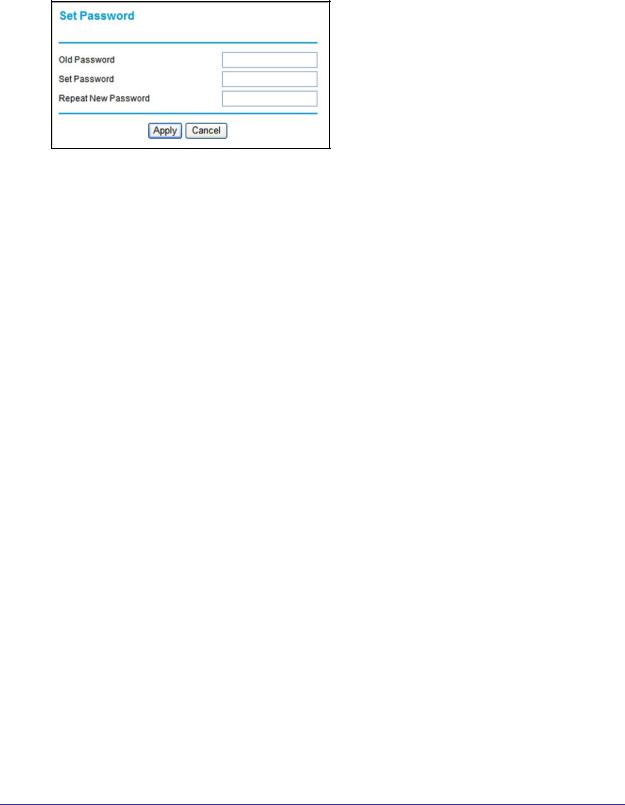
N750 Wireless Dual Band Gigabit Router WNDR4000 User Manual
To change the password:
1. Select Maintenance > Set Password to display the following screen:
2.Enter the old password.
3.Enter the new password twice.
4.Click Apply to save your changes.
After changing the password, you are required to log in again to continue the configuration. If you have backed up the wireless router settings previously, you should do a new backup so that the saved settings file includes the new password. See Back Up on page 52 for information about backing up your network configuration.
Log Out Manually
The wireless router interface provides a Logout command at the bottom of the wireless router menus. Log out when you expect to be away from your computer for a relatively long period of time.
Types of Logins
There are three separate types of logins that have different purposes. It is important that you understand the difference so that you know which login to use when.
•Router login logs you in to the wireless router interface. See Log In to the Router on page 17 for details about this login.
•ISP login logs you in to your Internet service. Your service provider has provided you with this login information in a letter or some other way. If you cannot find this login information, contact your service provider.
•Wi-Fi network name and passphrase logs you in to your wireless network. This login can be found on the label on the bottom of your unit. See Chapter 3, Wireless Settings for more information.
24 | Chapter 2. Set Up Your Internet Connection

3. Wireless Settings |
3 |
|
|
||
|
|
|
This chapter describes how to use the Wireless Settings screens to view and change (if needed) your wireless network settings. Security features to prevent objectionable content from reaching your PCs are covered in Chapter 4, Content Filtering Settings.
This chapter contains the following sections:
•Wireless Security Compatibility
•Security Basics
•Add Clients (Computers or Devices) to Your Network
•Wireless Settings Screen
•Wireless Guest Networks
Chapter 3. Wireless Settings | 25

N750 Wireless Dual Band Gigabit Router WNDR4000 User Manual
Wireless Security Compatibility
A wireless client is the wireless device or computer that will connect to your wireless router. Most PCs and laptops come with a wireless adapter installed, but if it is outdated or slow, you can purchase a new wireless USB adapter to plug into a USB port. Make sure the wireless adapter in each client in your wireless network supports WPA or WPA2 wireless security.
Note: If you connect devices to your wireless router using WPS as described in Wi-Fi Protected Setup (WPS) Method on page 28, those devices assume the security settings of the wireless router.
Security Basics
Unlike wired network data, wireless data transmissions extend beyond your walls and can be received by any device with a compatible wireless adapter (radio). For this reason, it is very important to use the security features available to you. Your wireless router has the security features described here and in Chapter 4, Content Filtering Settings.
•Wireless security options
•Turn off wireless connectivity
•Disable SSID broadcast
•Restrict access by MAC address
Wireless Security Options
A security option is the type of security protocol applied to your wireless network. The security protocol encrypts data transmissions and ensures that only trusted devices receive authorization to connect to your network. There are several types of encryption. WPA2 is the latest and most secure, and is recommended if your equipment supports it. WPA has several options including pre-shared key (PSK) encryption and 802.1x encryption for enterprises. Note that it is also possible to use your router without wireless security. NETGEAR does not recommend this. You can view or change the wireless security options in the Wireless Settings screen. See Wireless Settings Screen on page 29.
Turn Off Wireless Connectivity
You can turn off the wireless connectivity of the wireless router by pressing the Wireless On/Off button on its front panel . For example, if you use your laptop to wirelessly connect to your wireless router and you take a business trip, you can turn off the wireless portion of the wireless router while you are traveling. Other members of your household who use computers connected to the wireless router through Ethernet cables can still use the wireless router.
. For example, if you use your laptop to wirelessly connect to your wireless router and you take a business trip, you can turn off the wireless portion of the wireless router while you are traveling. Other members of your household who use computers connected to the wireless router through Ethernet cables can still use the wireless router.
26 | Chapter 3. Wireless Settings

N750 Wireless Dual Band Gigabit Router WNDR4000 User Manual
Disable SSID Broadcast
By default, the wireless router broadcasts its Wi-Fi network name (SSID) so devices can find it. If you change this setting to not allow the broadcast, wireless devices will not find your wireless router unless they are configured with the same SSID.
Note: Turning off SSID broadcast nullifies the wireless network discovery feature of some products such as Windows XP, but the data is still fully exposed to a determined snoop using specialized test equipment like wireless sniffers. If you allow the broadcast, be sure to keep wireless security enabled.
Restrict Access by MAC Address
You can enhance your network security by allowing access to only specific PCs based on their Media Access Control (MAC) addresses. You can restrict access to only trusted PCs so that unknown PCs cannot wirelessly connect to the wireless router. The wireless station MAC address filtering adds additional security protection to the wireless security option that you have in force. The access list determines which wireless hardware devices are allowed to connect to the wireless router by MAC address. See Advanced Wireless Settings on page 74 for the procedure.
Add Clients (Computers or Devices) to Your Network
Choose either the manual or the WPS method to add wireless computers or devices to your wireless network.
Manual Method
1.Open the software that manages your wireless connections on the wireless device (laptop computer, gaming device, iPhone) that you want to connect to your wireless router. This software scans for all wireless networks in your area.
2.Look for your network and select it. If you did not change the name of your network during the setup process, look for the default Wi-Fi network name (SSID) and select it. The default Wi-Fi network name (SSID) is located on the product label on the bottom of the wireless router.
3.Enter the wireless router passphrase and click Connect. The default wireless router passphrase is located on the product label on the bottom of the wireless router.
4.Repeat steps 1–3 to add other wireless devices.
Chapter 3. Wireless Settings | 27

N750 Wireless Dual Band Gigabit Router WNDR4000 User Manual
Wi-Fi Protected Setup (WPS) Method
Wi-Fi Protected Setup (WPS) is a standard that lets you easily join a secure wireless network with WPA or WPA2 wireless security. The wireless router automatically sets security for each computer or device that uses WPS to join the wireless network. To use WPS, make sure that your wireless devices are Wi-Fi certified and support WPS. NETGEAR products that use WPS call it Push 'N' Connect.1
Note: If the wireless network name (SSID) changes each time you add a WPS client, the Keep Existing Wireless Settings check box on the Advanced Wireless Settings screen has been cleared. See Advanced Wireless Settings on page 74 for more information about this setting.
You can use a WPS button or the wireless router interface method to add wireless computers and devices to your wireless network.
WPS Button Method
1.Press the  WPS button on the wireless router front panel.
WPS button on the wireless router front panel.
2.Within 2 minutes, press the WPS button on your wireless computer or device, or follow the WPS instructions that came with the computer. The device is now connected to your wireless router.
3.Repeat steps 1–2 to add other WPS wireless computers or devices.
Router Interface Method
1.Select Add WPS Client at the top of the wireless router menus.
2.Click Next. The following screen lets you select the method for adding the WPS client.
WPS Push Button method
3.Select either Push Button or PIN Number. With either method, the wireless router tries to communicate with the computer or wireless device, set the wireless security for wireless device, and allow it to join the wireless network.
1.For a list of other Wi-Fi-certified products available from NETGEAR, go to http://www.wi-fi.org.
28 | Chapter 3. Wireless Settings

N750 Wireless Dual Band Gigabit Router WNDR4000 User Manual
The PIN method displays this screen so you can enter the client security PIN number:
WPS PIN method
While the wireless router attempts to connect, the WPS LED on the front of the wireless router blinks green. When the wireless router establishes a WPS connection, the LED is solid green, and the wireless router WPS screen displays a confirmation message.
4. Repeat to add another WPS client to your network.
Wireless Settings Screen
The Wireless Settings screen lets you view or change the wireless network settings. When you set up security, note the new settings and save them in a secure location.
Note: If you use a wireless computer to change the wireless network name (SSID) or security options, you are disconnected when you click Apply. To avoid this problem, use a computer with a wired connection to access the wireless router.
Consider Every Device on Your Network
Before you begin, check the following:
•Every wireless computer has to be able to obtain an IP address by DHCP from the wireless router as described in Use Standard TCP/IP Properties for DHCP on page 16.
•Each computer or wireless adapter in your network has to have the same SSID and wireless mode (bandwidth/data rate) as the wireless router. Check that the wireless adapter on each computer can support the mode and security option you want to use.
•The security option on each wireless device in the network has to match the wireless router. For example, if you select a security option that requires a passphrase, be sure to use same passphrase for each wireless computer in the network.
Chapter 3. Wireless Settings | 29
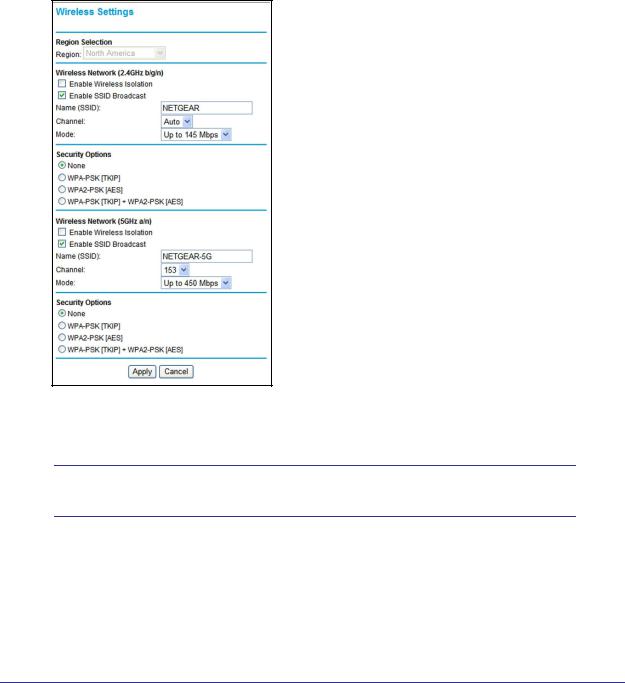
N750 Wireless Dual Band Gigabit Router WNDR4000 User Manual
View or Change Wireless Settings
Your wireless router comes set up with a unique wireless network name (SSID) and network password. This information is printed on the label for your wireless router. You view or change these settings in the Wireless Settings screen. You can also use this screen to set up guest wireless networks.
To view or change wireless settings:
1. Select Setup > Wireless Settings to display the following screen.
2.Select the wireless network that you want to configure.
3.Make any changes that are needed, and click Apply when done to save your settings.
Note: The screen sections, settings, and procedures are explained in the following sections.
4.Set up and test your computers for wireless connectivity:
a.Use your wireless computer or device to join your network. When prompted, enter the network password.
b.From the wirelessly connected computer, make sure that you can access the Internet.
30 | Chapter 3. Wireless Settings
